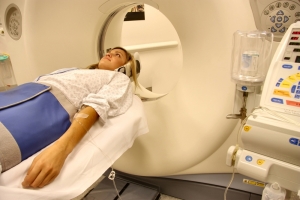Treatment of non-Hodgkin’s disease, also known as non-Hodgkin’s lymphoma (NHL), is discussed here.
In stage I and II disease (localized disease) for a low-grade lymphoma radiotherapy may be recommended, if there is evidence for local disease.
However, even in cases where it looked like there was local disease, there is often a relapse, even as late as 10 years or more after the radiotherapy treatment. This is different from Hodgkin’s disease and is proof that in NHL there is widespread disease early on. Intermediate-grade NHL requires chemotherapy and regional radiation, which in stage I and II will often cure the condition. High-grade lymphomas, including Burkitt’s lymphoma, must be treated with intensive combination chemotherapy including treatment of the central nervous system. This is true even for cases that look regional. Maintenance chemotherapy may be required, and often a cure can be expected.
In stage III and IV disease (advanced disease) of low-grade NHL treatment can vary between a single chemotherapeutic drug, interferon treatment or radio labeled antibody therapy. However, although initially things may look promising, often late relapses occur, which leads to an unfavorable overall prognosis.
The intermediate-grade NHL is best controlled with the CHOP regimen (cyclophosphamide, doxorubicin, vincristine, prednisone). About 50% to 70% will go into remission. 70% of the complete responders are cured. The outcome is poor for the high-grade NHL patient. Stem cell transplantation taken from peripheral blood cells or taken from the patient’s own bone marrow might prolong life. A cure may be achieved in 30% to 50% of eligible patients.
References:
1. N Engl J Med 329(14):987-994,1997.
2. The Merck Manual of Diagnosis and Therapy. 17th edition, editors M.Beers and R.Berkow. Whitehouse Station, N.J., 1999.
3. Cancer: Principles & Practice of Oncology. 4th edition, edited by V.T. DeVita et al., Lippincott Co., Philadelphia, 1993. Chapters 51 and 52.
4. Cancer: Principles&Practice of Oncology. 5th edition, volume 2. Edited by Vincent T. DeVita, Jr. et al. Lippincott-Raven Publ., Philadelphia,PA, 1997. Chapter 44,Lymphomas.
5. HY Dong et al. Mod Pathol 2001 May;14(5):472-481.
6. NL Kobrinsky et al. J Clin Oncol 2001 May 1;19(9):2390-2396.
7. Conn’s Current Therapy 2004, 56th ed., Copyright © 2004 Elsevier
8. Ferri: Ferri’s Clinical Advisor: Instant Diagnosis and Treatment, 2004 ed., Copyright © 2004 Mosby, Inc
9. Suzanne Somers: “Breakthrough” Eight Steps to Wellness– Life-altering Secrets from Today’s Cutting-edge Doctors”, Crown Publishers, 2008







